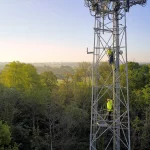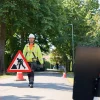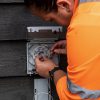Acrimony as UK Parliament Debate Use of Telegraph Poles for Broadband

The vexed question of whether it’s always right to use “telegraph poles“, which are far from popular with many UK communities, when deploying the new generation of gigabit broadband ISP networks came up for debate in parliament yesterday. MPs broadly called for change and stronger rules are coming “early” in 2025, but whether they will be enough remains to be seen.
First things first. The United Kingdom, not unlike many other countries, is already home to millions of poles (both wood and metal) – these are frequently used for electricity distribution and street lighting, as well as telecoms and smart sensors. Suffice to say that poles are a common sight across the country (if you live in such an area then they’re as normal as traffic lights) and form a key part of how gigabit broadband operators are choosing to deploy new full fibre (FTTP) networks.
Telecoms operators typically like poles because they’re very quick and cost-effective to build (several times cheaper than trenching), can be deployed in areas where there may be no space or access to safely put new underground cables, are less disruptive (avoiding the noise, access restrictions and damage to pavements of street works) and can be built under Permitted Development (PD) rights with only minimal prior notice.
Advertisement
The previous government, driven by its targets for expanding gigabit-capable broadband infrastructure “nationwide” (c.99% coverage) by 2030 under their £5bn Project Gigabit programme, even facilitated this by cutting red tape to help make such work as easy as possible. This, along with other changes and investment programmes, has helped to attract tens of billions of pounds in private investment and spurred a massive commercial deployment of new networks.
As a result of all that, some 85% of premises across the UK now have access to gigabit-capable broadband services (here), and Ofcom predicts this will reach around 97-98% by May 2027 (here). So far this approach has clearly been successful. But poles aren’t everybody’s cup of tea and, with such a significant amount of related civil engineering occurring, it’s perhaps no surprise that there has also been a rise in complaints from residents.
The parliamentary debate
Over the last few years’ we’ve reported on multiple complaints and protests against the deployment of poles – these are often particularly common in areas that haven’t previously had poles before (i.e. the past infrastructure was underground) or where several gigabit broadband networks may already exist.
Related issues typically highlight the negative visual appearance of poles, as well as concerns about their exposure to damage from major storms, the lack of effective prior consultation (often there isn’t any, except an easily missed notice on the street), creating obstructions for pavement users when poorly placed (e.g. wheelchairs, prams), the duplication of existing infrastructure or engineers that fail to follow safety rules while building etc.
Advertisement
Yesterday’s debate in parliament, which was tabled by Labour MP Laurence Turner, saw other ministers echo the aforementioned complaints from their own constituencies (there was little sympathy for network operators). Some MPs also highlighted issues where strong protests by local residents are completely ignored or operators had pledged to only build underground, before later deploying poles (note: plans can change after engineering surveys, which may identify problems). The issue of poor community engagement was a common complaint.
Laurence Turner MP said:
“In seeking to address these concerns, a number of residents in my constituency have, individually and collectively, attempted to follow the steps set out in the code of practice, including the complaints process. However, the code of practice, in its current form, fails to provide sufficient redress. It states that a complaints procedure should be in place, but it fails to go further than a company providing written responses detailing why a complaint is accepted or rejected. Frankly, that is not good enough. We must focus on preventing poor practice, as well as encouraging the best.”
Finally, there were the usual calls for greater infrastructure sharing, which is an extremely complicated area. Some MPs and their constituents believe this is an easy problem to resolve and have a tendency to over-simplify the challenges. Alex Ballinger MP (Labour) asked: “Does my hon. Friend agree that if there is accessible infrastructure underground already, broadband providers should use that?” If only it were so easy.
Most network operators already do everything possible to share existing poles and ducts, since that’s a lot more cost-efficient than building new stuff (e.g. Openreach’s network is widely re-used by rivals via a regulated solution as they have a dominant market position). But this isn’t available to every location and sometimes local restrictions, as well as any limitations (commercial or practical) imposed by existing operators, mean that it’s not always possible (e.g. sometimes no viable underground alternatives exist to poles, such as if past cables have been direct buried without ducts).
Meanwhile, a smaller network operator might build a new trench and ducting but keep it closed to rivals in order to protect the value of that high-risk investment (i.e. not allowing other altnets a free ride). If they weren’t able to do that, then they might have just built poles instead or not deployed at all.
Advertisement
The existing Access to Infrastructure (ATI) Regulations 2016, which applies to all operators, does include provisions on the exchange of information about existing infrastructure, and the right to access that infrastructure on fair and reasonable commercial terms etc. But this doesn’t matter much if a commercially viable deal cannot be reached. However, the recent efforts between Connexin, MS3 and KCOM in Hull suggest that, with enough of a push, solutions can sometimes still be found (here). But KCOM also has an incumbent position in Hull, which means they face regulatory pressures that other altnets do not.
Click over to read the government’s response on page 2..
Mark is a professional technology writer, IT consultant and computer engineer from Dorset (England), he also founded ISPreview in 1999 and enjoys analysing the latest telecoms and broadband developments. Find me on X (Twitter), Mastodon, Facebook, BlueSky, Threads.net and Linkedin.
« Virgin Media UK Rename Stream TV to Flex and Add £5 Monthly Fee






















































The fibre roll out has been a good example of what can be achieved if you get rid of unnecessary red tape and take away the power of NIMBYs to block everything. It’s a test for the new government because they are going to have face down far sterner opposition than this if they want to reform planning laws in order to meet their housing targets.
The red tape was there to protect against the exploitation that many of the code operators are using within permitted development for telecommunications installations ,voluntary codes of practise and non adherence to ECC (2003) to install UNNECESSARY infrastructure rather than seek to share infrastructure . Lack of planning or regulation of the telecommunications industry has led to the chaotic overbuild of infrastructure , Rather than addressing areas without the connectivity or in the guise of providing choice of ISPs which could have been addressed without triple or more of infrastructure
Honestly in a ideal world as an ISP I’d like to use somebody elses’ pole at a sensible price for my build, but do I want to sell access to mine to another ISP? Ideally not, unless it’s reciprocal.
This is the main issue, nobody *wants* to share their infrastructure for a fair price, so we put in our own poles. I’ve looked into using electricity company poles and so on under ATI but it’s way more hassle than it’s worth, planting a pole costs £550~ all in, even negotiating ATI for 100 poles(inc system to notify, integrate GIS, train staff, be billed/correct bills etc) – it’s cheaper to just get on and install new ones ourselves.
Similar story for other ISPs, we tried getting duct access to duct put in with BDUK money (we are building without) and it was 2K to get access and 29p metre a year per 4mm duct.. with PIA we get 25mm can install 20X the fibre per duct and it costs much less? Dark fibre is a even more insane story.
Look forward to responses in the comments from: https://www.ispreview.co.uk/index.php/2024/10/ms3-begin-trial-to-run-fttp-broadband-via-kcoms-poles-in-hull-uk.html
You keep quoting the ECC and other things so given you’ve been at this for a year and more I’m sure you can answer my layman points and show me where I’m wrong.
John, “NIMBYS” – a divisive labelling project by people who take offence at others who do not agree with their plans without asking what the reasons are and seeing if they can be alleviated.
Secondly, your comment, “and take away the power of NIMBYs to block everything”, THAT is what an authoritarian state would do and not a modern democratic one.
Politicians, councillors and backhanders – you want them to be able to do what they want wherever they want under the guise of spill that everyone benefits…hmmmmmmm
The only reason they prefer poles is money. They use the cheapest easiest option to spread their network as fast as possible so they can sell their company off, its all a quick cash grab.
If they were serious about providing a network and service, they would prefer underground cabling as it is more cost effective long term.
Anything else they say other than cost is just irrelevant PR speak.
Nobody would care for a few days of road works on their street if they knew what it was for, short term disruption is better than long term.
Poles having always existed is also a null point, upgrading the countries telecoms network is the perfect time to live in the present and do the job properly.
Given that it can take weeks to repair a downed telegraph pole perhaps if “incentives” were put in place to make repairs take place much quicker they would be less likely to go for the cheap upfront method. Basically at the moment they are incentivised to put the cost of your broadband being down for days on the consumer.
Totally Agree . It seems odd that for the last 50 years or more telecommunications infrastructure has been installed increasingly underground and now it’s considered progress to install multiples of telegraph poles
Untrue. Poles are cheaper over the lifetime of fibre.
Anon the cost differential between a pole and.an underground solution is around 2 to 3 time more expensive to do the underground .you paying the difference then
It is true, underground infrastructure is considerably less prone to damage. Poles are useful for the last percent of homes, the super rural ones, but underground should be the de facto standard for infrastructure. Defending poles in situations where they dont make sense is crazy to me. You can wait another 6 months for your fibre, we dont need to take shortcuts because a minority wants their fibre and they want it now!
Also fibre rollout should have been treated as a utilty, with only one cable being run to each home.
It’s not about waiting 6 months anon, it’s about whether it gets delivered at all. Margins are thin. If you put in place rules that make it cost three times as much to deliver to a property then that property doesn’t get fibre.
Network rollouts are funded by investors who want to see a return. If you increase the cost so that they don’t have any prospect of a return they’ll put their money elsewhere.
As always the devil in detail. Places served by grass verges owned by council/highways/state are easy to micro trench and whilst there is a bit of cost over just pole mounting, it could be used in part to get cable from pole to pole rather than strewn across long lengths that sag. So roads with grass verge all along one side for example, cables could be micro trenched and buried, even if the final drop wire is from a pole. It all helps to reduce clutter of wiring.
Another scenario, I’ve seen Brokenreach do a fibre feed to another CBT on another pole by running a cable from the feeding pole. Usually a pole will have its own independent feed from existing underground route, but some areas and local engineers do the quickest route and the result is spaghetti wiring on a once clean road.
Exactly, the whole point of moving from Copper to FTTP is to bring about an improvement. As the Internet is becoming a vital service, then upgrading copper should mean if its overhead it goes to being underground, especially given all the talk about climate change and worsening weather, well if that is true then legislation should be in place to ensure new infrastructure is as climate change proof as possible.
Also we don’t put gas or water pipes over head, and electricity is almost always underground, granted some houses do have overhead supplies, but its a very small fraction and all new installations are underground.
Then on top of all that sensibility, many people don’t like them, especially if they were not there before.
The solution is IMHO simple. If the existing phone service is provided by telegraph poles then a few more is fine. If the existing phone service is underground then you need planning permission to put in telegraph poles.
The result will be simple too. Operators won’t apply for planning permission, they’ll just rollout fibre to other places instead.
That’s where an effective regulator could step in. Too much of cherry picking going on, and many easy places have 2/3/4+ operators and others (not talking of remote locations) have nothing.
That’s not regulation, that’s competition. Operators are free to deploy network wherever they believe they can make a return. Overbuild is a sign of the market working properly. Anything else would suggest collusion or non-compete arrangements which break the Competition Act and tend to get people sent to prison.
“now it’s considered progress to install multiples of telegraph poles” – where on earth is that the case?
Talking of burying everything, I’m so glad that the parent of the NTL did so well…. oh apart from going majorly bust.
They didn’t have micro-trenching equipment back then which is much easier and cheaper to do.
DSIT are branding activists in the same way as 5G conspiracy theorists.
The lady at connected britain was rolling her eyes at having to attend.
The Government won’t stop anything and will alienate people who try to challenge.
Some of the poles rushed into place where I live are already starting to lean. They have so many cables attached it was bound to happen. The cables are covering a far greater distance than they should. This is obvious to anyone just looking. All down to cost I suppose, and sod the end result.
Where I live we have had Openreach underground cables and wooden poles presumably since the GPO rolled out the phone network. We then had Nynex lay a load of underground cables before going bust and being taken over by Virgin. So we already have one hybrid cable and pole and one cable only network. Now IXL are putting up their own set of poles. These form a cats cradle with Openreach’s cables as Openreach’s are often crossing the roads while IXL’s are running parallel to the roads. It looks like some third world mess. It seems very unlikely that there is sufficient business to support 3 broadband supplies so I guess one may go bust like Nynex did leaving their infrastructure to rot where it stands or lies depending on who goes bust.
NYNEX didn’t go bust, Andy. They were merged into Cable and Wireless Communications and bought by ntl. ntl went into Chapter 11 bankruptcy protection in the USA but did not go bust. Shareholders were basically wiped out and creditors took over the company.
IXL – are you talking about IX Wireless? They haven’t behaved well at all: they are in the minority and I’m sorry your area has had them do that. Most would’ve used the existing Openreach poles. They don’t as they’ve specific requirements leaving them about the only altnet for whom it might be cheaper in the short-medium term to build their own than use Openreach.
IX Wireless is awful. They go by many other names such as Opus and the dreadfully misleading 6G Internet. They’re a company as old as Time (hint to their origin).
As for poles vs underground, as a former fault manager for an ISP, the overhead FTTP is the most unreliable part of the networks as the poles are vulnerable to vehicular damage, wear and tear (they rot and can be deemed unsafe to climb), and repairs can take weeks, and that’s before we talk about how storm damage can take weeks to resolve if the suppliers have to apply for an A55 off the local authority.
Underground is more disruptive to put in, but once it’s in, it’s in and provided decent materials are used to create the ducts, there isn’t much need to excavate the lines again.
What I don’t like, however, is how many ISPs seem to be running their own kit in a given area. Someone I know has Virgin, Openreach, Cityfibre, and Grain, who have all installed their own separate network underground, in the last 18 months. There’s no off road parking, so it’s a nightmare down her street when the networks want to roll out.
Our community has had cable phone and internet for decades. There were a few poles about which was fine. Recently more have appeared and now there’s one pretty much every two houses. Each one is like a may pole with the amount of cables coming off and have become very popular with birds. For most of the day it’s like the Hitchcock film – even in December – and the cars, gardens and pavements are covered in bird poop.
Is there anything that can be done? In 2024 I can’t see why we needed more poles when presumably each property was already connected to one. I’ve never taken much notice of telegraph poles wherever I’ve lived but our street and the ones adjacent to it look like we’re living under a giant spider’s web!
How does a member of the public lay their own cable in an Openreach duct to connect any two buildings?